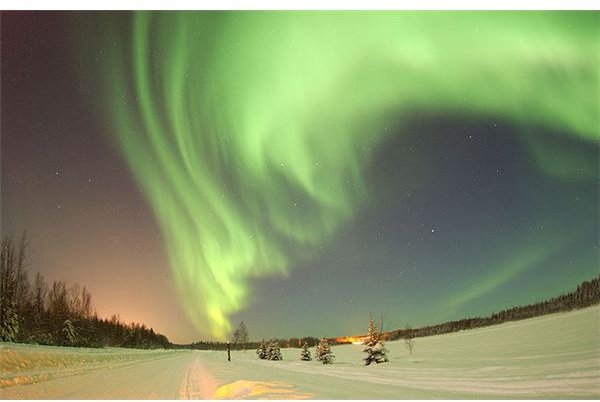Fast Facts on the Arctic Northern Lights (Aurora Borealis)
Facts About the Northern Lights
If you live in a colder climate you may have noticed long greenish swirls in the night sky from time to time. These are the Northern Lights! Learn some facts about them to help you understand what the arctic Northern Lights are and how they are formed.
How They are Formed
The Northern Lights are a result of activity happening in the Earth’s upper atmosphere due to the Sun.
The Sun sends out all kinds of radiation such as X-rays and ultra violet (UV) rays into the Solar System. The Earth has a protective magnetic shield that deflects most of the incoming radiation from the Sun, but sometimes the Sun also emits fast moving particles which collectively are known as the solar wind. This solar wind reaches the Earth and is deflected by the Earth’s magnetic field. However, sometimes a portion of the solar wind enters the Earth’s atmosphere near the North and South Poles. When these fast moving particles bump into the atoms of gases in the upper atmosphere, they energize the gases causing them to glow in a spectacular display we see as the Northern Lights. Similarly, in the Southern hemisphere the lights are known as Aurora Australis. The lights only occur in the Northern and Southern hemisphere as the magnetic field of the Earth attracts the charged particles towards the North and South poles.
The lights are a result of the solar wind which causes them to form oval rings near the North pole. If the solar wind is strong, then the rings will be larger. When the Sun is less active these rings are thinner and stay closer to the North Pole. When the Sun is very active the rings are larger and move further south.
Fun Facts
Another name for the Northern Lights is the Aurora Borealis.
The Northern Lights come in all different colors ranging from orange, red, yellow, blue and green.
The colors are as a result of different gases such as oxygen and nitrogen giving off light due to the particles striking them.
The colors green and yellow are produced by oxygen, while the colors red, violet, purple and blue are produced by nitrogen. Violets will sometimes form a border around the green auroras at lower altitudes.
The lights occur very high up in the atmosphere of the Earth. Sometimes one can see an all red aurora when these lights take place at heights of over 200 miles up. This is very rare and occurs when these charged particles coming from the Sun strike oxygen atoms high up in the atmosphere causing them to give off red light. It is common to see a greenish-yellow aurora, which takes place about 60 miles up in the atmosphere.
The lights appear in the night sky to be either still or sometimes dancing, forming columns and different shapes. This is because when the Sun is very active more of the particles enter the atmosphere of the Earth because of a strong solar wind. This results in the dancing patterns of the lights. However, if the Sun is less active the lights will appear to be still in the night sky.
No two Northern Lights are the same. They are always of different sizes and different colors.
People in the olden days thought that the lights were a result of sunlight coming off of the arctic ice. It was only in the last 50 years that with better technology scientists were able to find out what actually causes the lights. Canadian scientists launched a satellite to study the lights called Alouette.
The word Aurora comes from the Roman goddess of dawn, while Borealis is named after the Greek word for wind, Borea.
The Native American Inuit people call the aurora aqsarniit, which means football players. They say that spirits in the sky are playing football with the head of a Walrus.
The winter season is the best time to see the lights.
During the winter, these lights can be seen from the Arctic even during the afternoon.
The Arctic is one of the best places to see the auroras. In general, the further North you are the better the chances of seeing an Aurora.
The best time to see the lights is late evening between the hours of 10pm and 2am.
Where Can I See the Lights?

Fall and winter are the best times to see auroas in the Northern Hemisphere. You can try to find places with dark skies away from cities and streetlights.
There are many good locations to see the lights from and a planned trip to see them would be all that much more exciting. One good location in Canada is the town of Whitehorse in the province of Yukon Territory. Calgary in Alberta and the province of Manitoba are also good places to spot them from. During periods of increased solar activity, particularly when strong solar flares occur, auroras are visible from more southern locations. You can visit www.spaceweather.com to find out when an Aurora can be seen if you are further South. Just make sure you dress warmly!
Credits
1. https://www.lyngenlodge.com/the-northern-lights/aurora-facts
2. https://library.thinkquest.org/22550/northernlights.html
3. https://docs.google.com/viewer?a=v&q=cache:orfBdjnlax4J:www.asc-csa.gc.ca/pdf/educator-northern_lights.pdf+how+northern+lights+are+formed&hl=en&gl=ca&pid=bl&srcid=ADGEESi7F5x2cmhQwbdTdUaDaWw1C-1ok8tNHeQxcbJvfsFzMufjTEQxNk10wO5m2pISyL0f-JO53vb_0kxPs-RIR1VoozQA0rnGMMQ5kpIqv6p4omoK6YGuscCzYAGj5Lh-PH0DWdCE&sig=AHIEtbSPjN6Wu_BBtd9Bjl-wMORu7qftzw
Image Credits:WikimediaCommons/UnitedStatesAirForceSeniorAirmanJoshuaStrang/UnitedStatesFederalGovernment
